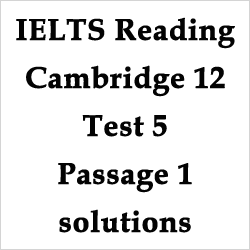IELTS Reading: Cambridge 12 Test 5 Passage 1; Cork – solutions with explanations
This post on IELTS Reading deals with the in-depth analysis of Cambridge 12 Test 5 Reading Passage 1. The passage is entitled ‘Cork‘. I’ve provided all the solutions here with some detailed explanations. Please, get the book Cambridge IELTS series 12 when you read the post. It will surely help you to find out the answers from the passage.

CAMBRIDGE IELTS 12 – TEST 1 – PASSAGE 1
Title of Reading Passage 1: Cork
Question 1-5 : TRUE, FALSE, NOT GIVEN
Note: This type of question maintains a sequence. So, if you find the answer to question 2 in the first few lines of Paragraph 2, look for the answer to question 1 in paragraph 1.
Strategies to answer the questions: This post may help you to answer this type of question easily.
https://ieltsdeal.com/2018/01/13/ielts-reading-a-smart-strategy-to-handle-yes-no-not-given/
Now let’s look at the questions and explanations.
- The cork oak has the thickest bark of any living tree.
Keywords for the question: thickest bark
In paragraph 1 of the passage the author mentions, “Cork- the thick bark of the cork oak tree (Quercus suber) – is a remarkable material.” Again, in paragraph 2, the author mentions, “Its bark grows up to 20cm in thickness.” In both these lines, the word THICK is available. But, in our question, the phrase is the thickest bark. Here, the word thickest is in the superlative form of an adjective, which means this tree has to be in rank no. 1 as far as thickness is concerned. There is no such comparison in the passage and it means that our answer is not available in the passage.
So, the answer is: NOT GIVEN
- Scientists have developed a synthetic cork with the same cellular structure as natural cork.
Keywords for the question: synthetic cork, same cellular structure, natural cork
In paragraph 2 lines 9-13, the author mentions the cellular structure of the bark of the cork oak “ . . .. .. the bark of the cork oak has a particular cellular structure – with about 40 million cells per cubic centimetre – that technology has never succeeded in replicating”.
Here, there is a clear contradiction or disagreement between the question and the above-quoted text from the passage. The question says, scientists have developed or discovered or invented an artificial synthetic cork that matches the cellular structure of natural cork. But the words “technology has never succeeded in replicating” means that technology or scientists have not been successful to make anything similar to the natural cork, with all of the same qualities.
Here, the word replicate may create confusion as a new or unknown word, which means duplicate or same.
So, the answer is: FALSE
- Individual cork oak trees must be left for 25 years between the first and second harvest.
Keywords for the question: individual, 25 years, the first and second harvest
Take a close look at paragraph 4, which talks about the harvesting of an individual cork oak tree. The author says, “From the planting of a cork sapling to the first harvest takes 25 years, and a gap of approximately a decade must separate harvests from an individual tree”.
* Approximately a decade = nearly 10 years. So, the gap is 10 years, not 25 years.
* A gap = must be left……….. between
So, the answer is: FALSE
Note: If there is only a numeric (number) difference between the question and the passage, the answer is always False. Here is a picture to explain question no. 3 in a better way.

- Cork bark should be stripped in dry atmospheric conditions.
Keywords for the question: stripped, dry atmospheric conditions
The word stripped is directly mentioned in paragraph 4 (Follow the order of the text from the previous question). Here, in line 15 the author states, “If the bark is stripped on a day when it’s too cold – or when the air is damp – the tree will be damaged”.
This text agrees with the question, but in a reverse pattern. Here, the word “damp” is antonym for the word “dry”. So, the bark should not be stripped in damp atmospheric conditions; rather, it needs to be stripped in dry atmospheric conditions.
So, the answer is: TRUE
- The only way to remove the bark from cork oak trees is by hand.
Keywords for the question: only way, remove, by hand
The answer is available in paragraph 5, where the author maintains, “No mechanical means of stripping cork bark has been invented, so the job is done by teams of highly skilled workers.”
Stripping = remove
Since the author’s negative statement “no mechanical means has been invented” suggests that there is no mechanical technology available to remove the bark, it has to be done by hand (the hands of highly skilled workers).
So, the answer is: TRUE
Question 6-13: NOTE-COMPLETION (One word only)
Note: This type of question is nothing more than filling in the blanks. Read the title of the note, which is very important to have an idea about the questions and targeted paragraphs to find the answers.
- do not affect the ___________ of the bottle contents
Keywords for the question: affect, bottle contents
First, find the main keyword “bottle contents” and then scan the line carefully.
The author states in paragraph 6, “Recent years have seen the end of the virtual monopoly of cork as the material for bottle stoppers, due to concerns about the effect it may have on the contents of the bottle…..The tiniest concentrations – as little as three or four parts to a trillion – can spoil the taste of the product contained in the bottle. The result has been a gradual yet steady move first towards plastic stoppers and, more recently, to aluminium screw caps.”
Here, look at the synonymous links.
- Affect = spoil
• Bottle contents = the product contained in the bottle
These lines indicate that aluminium screw caps overcame one disadvantage of cork bottle stoppers, which is that they “spoil the taste of the product contained in the bottle”. So, we understand from here that aluminium screw caps do not affect the taste of the product inside the bottle.
So, the answer is: taste
- are ________ to produce
Keywords for the question: produce
- are _______ to use
Keywords for the question: use
In the final sentence of paragraph 6, the author states, “These substitutes are cheaper to manufacture and, in the case of screw caps, more convenient for the user”.
Here,
These substitutes = aluminium screw caps
Manufacture = produce,
for the user = to use
So, we can gather the meaning from here that they are cheaper to produce and more convenient for the user. However, the question requires ONE WORD ONLY, so the answers for questions 7 and 8 have to be “cheaper” and “convenient”.
- Produce = manufacture
- To use = for the user
So, the answers are:
7. cheaper
8. convenient
- Suit the ______ of quality products
Keywords for the question: suit, quality products
We find some information about quality products in the sentence in paragraph 7 line 3: “Firstly, its(the cork bottle stopper) traditional image is more in keeping with that of the type of high-quality goods with which it has long been associated”.
Here, the phrase “in keeping with” means “suit”. So the answer is “traditional image”, but the answer requires only one word, so it has to be “image”. It is because you have to choose a noun between a noun and an adjective.
- Products = goods
• In keeping with = suit
So, the answer is: image
- made from a ______ material
Keywords for the question: made from, material
- easily ______
In the very following sentence, the author mentions “Secondly – and very importantly – cork is a sustainable product that can be recycled without difficulty”.
Recycling often is linked with the material. So the author is referring to its material here. The answer is
“sustainable” and “recycled”
Here, without difficulty = easily
So, the answers are:
10. sustainable
11. recycled
- cork forests aid _______
Keywords for the question: cork forests, aid
- cork forests stop _____ happening
Keywords for the question: cork forests, stop
In paragraph 7 line 9, in the end, the author states about the cork forests – “Moreover, cork forests are a resource which support local biodiversity, and prevent desertification in the regions where they are planted. So, given the current concerns about environmental issues, the future of this ancient material once again looks promising”.
Here, support = aid
Prevent = stop.
So the answers are clearly “biodiversity” and “desertification”
So, the answers are:
12. Biodiversity
13. Desertification
This is the end of the post.
Click here for solutions to Cambridge 12 Test 5 Reading Passage 2
Click here for solutions to Cambridge 12 Test 5 Reading Passage 3




It is really useful, Thanks a lot for sharing these information.
you’re welcome. if u have any query, don’t be shy to share.
I have a in reading
Thank you so much ❤️
Hi
Tnx a lot it’s so useful
Dear Elma Karimi,
Thanks for your comment.
Hello, You know in the second question there is “scientists” word which is not in the text. But I choose NOT GIVEN for this question bc of this incomplete info in the text. It is not clear wether scientists developed the tech or not” may be other people developed for example engineers. If the question says engineers developed, in this case the text says scientists. It should be false. Why is it like that?
Here, there is a clear contradiction or disagreement between the question and the above-quoted text from the passage. The question says, scientists have developed or discovered or invented an artificial synthetic cork that matches the cellular structure of natural cork. But the words “technology has never succeeded in replicating” means that technology or scientists have not been successful to make anything similar to the natural cork, with all of the same qualities.
thank alot for the torrent of useful information
You’re welcome!
Hello, thanks for your great effort.
There is something wrong with this link
http://ieltsdeal.com/2018/04/05/ielts-reading-cambridge-12-test-5-passage-3-whats-the-purpose-of-gaining-knowledge-solutions-with-explanations/
Dear Osama,
I’ve fixed it. Check again now.
It is very useful for me. Thank You
i do not actually agree with the answer to the question of 3, in my opinion the correct answer is ‘true’, because there is a statement follows ” for top-quality cork, it is necessary to wait further 15 or 20years” , with that being said, it means a decade + further 15 years = 25 years, correct me if i am wrong. thank you
Hello Javid, Thanks for the question. Unfortunately, did not understand the question correctly. I’ve included a picture with the post to explain the question for you. Here’s the picture again:
http://ieltsdeal.com/n_content/uploads/2018/04/cam-12-test-5-reading-passage-1-explanation.png
i still dont undestand 29th question
Very nice way to eXplain,thank u so much
Thank you.
i still dont understand q3 clearly because in the passage the author said” a gap of approximately a decade must seperate harvests from an individual tree”, so it means that there are more than one harvest until it becomes an individual tree. Therefore, i think that the answer should be not given.
Take a close look at the picture.
wow, thanks a ton
Welcome!
Very helpful ?
well explanation, anyone can easily understand
Thanks a bunch for creating this website. This is the best website to boost reading skills, because I easily can find my mistake and make them correct. I really appreciate you hard work.